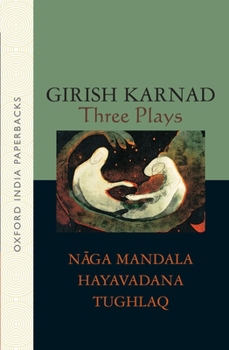Three Plays: Naga-Mandala; Hayavadana; Tughlaq
Select Format
Select Condition 
Book Overview
These plays represent three phases in the career of the dramatist Girish Karnad, all three are classics of the Indian stage. The first play, Tughlaq, is a historical play in the manner of nineteenth-century Parsee theater. The second, Hayavadana was one of the first modern Indian plays to employ traditional theatrical techniques. In Naga-Mandala, the third play, Karnad turns to oral tales, usually narrated by women. This selected work of one of India's...
Format:Paperback
Language:English
ISBN:0195637658
ISBN13:9780195637656
Release Date:February 1996
Publisher:Oxford University Press, USA
Length:228 Pages
Weight:0.50 lbs.
Dimensions:0.6" x 5.5" x 8.4"
Customer Reviews
1 rating
P. MENCKE
Published by Thriftbooks.com User , 14 years ago
This is an amazing look at the history of playwriting in India after British rule ended. The author explains how playwrights are attempting to incorporate Indian local theater, which is mostly based on myths apparenty, into other modes of playwriting and play presentations with the use of lighting, the proscenium, and new forms of stories and ideas. Very interesting. He also introduces each of his three plays with a bit of explanation to help western theater enthusiasts understand the form of his plays. While I would usually not want to hear from any artist a prologue to the presentation of a piece of art, since the work of art, in my opinion, must stand alone on it's own merits without the intentions of the artist or any background information presented ahead of time; I found this somewhat helpful in this case, where foreign myths are involved. This book is written to help Westerners understand the current state of East Indian theater art while presenting this playwrights work. It might, otherwise, have let us pass it up as trivial without the historical background. After reading the entirety of this Book, it is easier to separate Bollywood from more creative works in India. At a time when teaching any information through parable or myth is in question, since young minds tend to believe such mythical characters actually exist no matter how fantastic, I applaud this author for his work of attempting to update the content and presentation of Indian plays. In he case of India, where there are hundreds of gods who are more of less dealt with as though they truly exist, this is a refreshing idea that America could learn from. This author also seems to want to retain theater's ability to present large ideas effectively, and that too is laudable.






